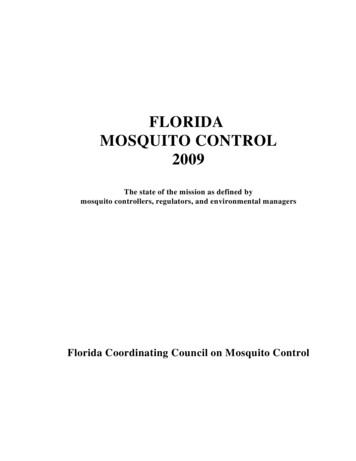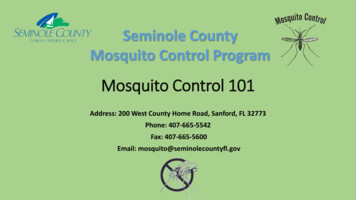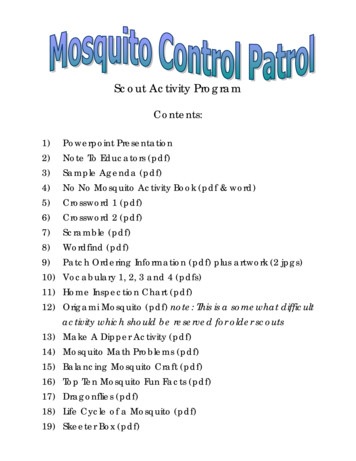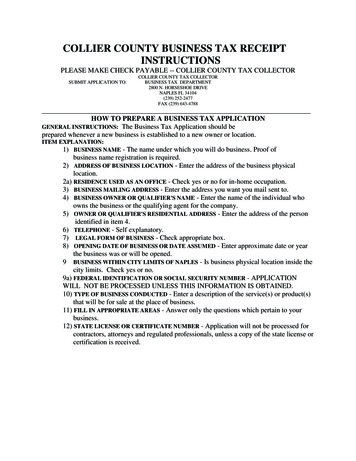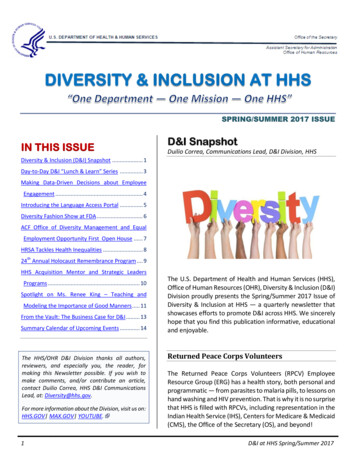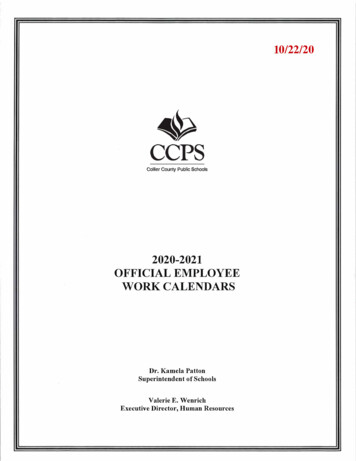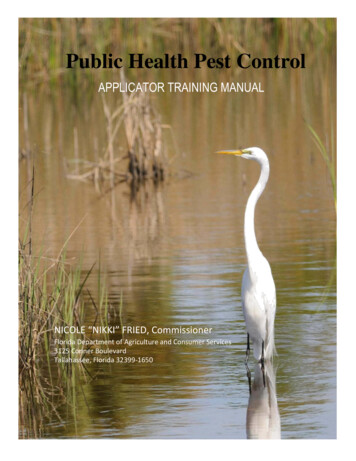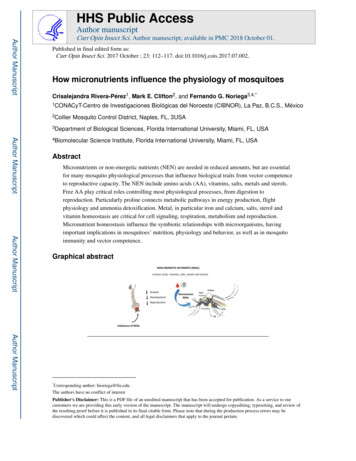
Transcription
HHS Public AccessAuthor manuscriptAuthor ManuscriptCurr Opin Insect Sci. Author manuscript; available in PMC 2018 October 01.Published in final edited form as:Curr Opin Insect Sci. 2017 October ; 23: 112–117. doi:10.1016/j.cois.2017.07.002.How micronutrients influence the physiology of mosquitoesCrisalejandra Rivera-Pérez1, Mark E. Clifton2, and Fernando G. Noriega3,4,*1CONACyT-Centro2Collierde Investigaciones Biológicas del Noroeste (CIBNOR), La Paz, B.C.S., MéxicoMosquito Control District, Naples, FL, 3USA3Departmentof Biological Sciences, Florida International University, Miami, FL, USAAuthor Manuscript4BiomolecularScience Institute, Florida International University, Miami, FL, USAAbstractAuthor ManuscriptMicronutrients or non-energetic nutrients (NEN) are needed in reduced amounts, but are essentialfor many mosquito physiological processes that influence biological traits from vector competenceto reproductive capacity. The NEN include amino acids (AA), vitamins, salts, metals and sterols.Free AA play critical roles controlling most physiological processes, from digestion toreproduction. Particularly proline connects metabolic pathways in energy production, flightphysiology and ammonia detoxification. Metal, in particular iron and calcium, salts, sterol andvitamin homeostasis are critical for cell signaling, respiration, metabolism and reproduction.Micronutrient homeostasis influence the symbiotic relationships with microorganisms, havingimportant implications in mosquitoes’ nutrition, physiology and behavior, as well as in mosquitoimmunity and vector competence.Graphical abstractAuthor Manuscript*Corresponding author: fnoriega@fiu.edu.The authors have no conflict of interestPublisher's Disclaimer: This is a PDF file of an unedited manuscript that has been accepted for publication. As a service to ourcustomers we are providing this early version of the manuscript. The manuscript will undergo copyediting, typesetting, and review ofthe resulting proof before it is published in its final citable form. Please note that during the production process errors may bediscovered which could affect the content, and all legal disclaimers that apply to the journal pertain.
Rivera-Pérez et al.Page 2Author ManuscriptIntroductionAdult female mosquitoes of several species are important vectors of human diseases. Due toa primarily hematophagous feeding strategy and the ability to produce offspring, moststudies in mosquitoes have naturally focused on the adult female. Aedes aegypti, inparticular, have received the majority of attention because of its ease of rearing, desiccationresistant eggs, cosmopolitan distribution and vector importance. Those factors have allconverged to make Ae. aegypti a model organism. Nutrition strongly influences thephysiology and behavior of mosquitoes. A sugar meal can sustain the energetic requirementsof a female Ae. aegypti, and blood meals are required to produce eggs. However, much lessis known about particular nutrients required during larval stages or about the importance ofspecific components of a sugar or blood meal in completing oogenesis.Author ManuscriptFor the purposes of this review, the nutritional requirements of mosquitoes can be dividedinto two main classes: energetic nutrients (so-called macronutrients) such as carbohydrates,fatty acids and some amino acids [1,2,3] and micronutrients or non-energetic nutrients(NEN). NEN are needed in reduced amounts but are essential for proper cellular andorganismal function [4]. The NEN’s include vitamins, salts, metals as well as sterols. Manyamino acids (AA) can also be considered micronutrients because they are not used as a mainsource of energy, yet they are indispensable [4,5]. While energy-providing nutrients havereceived full attention regarding their impact on the physiology, behavior and ecology ofinsects, NEN have been largely overlooked. This review summarizes the current knowledgeon the influence of NEN homeostasis on physiology of mosquitoes, and stresses some majorgaps in our understanding of these processes.Author ManuscriptNon-energetic nutrient homeostasisAuthor ManuscriptThe physiology of adult female mosquitoes is markedly linked to the gonotrophic cycle.Ovarian development in Ae. aegypti can be divided into three distinct phases:previtellogenesis (PVG), oocyte state-of-arrest (ORS) and vitellogenesis (VG) [6,7]. Toprovide the energy, molecular building blocks and NEN for ovarian development, the femalemosquito draws nutrition from three main feeding modalities: larval feeding, adult sugarfeeding, and adult blood feeding. Each of these processes provides a unique repertoire ofNENs. Mosquito larvae mostly filter feed particulate matter such as phytoplankton,microorganisms, and detritus [8]. The nutrition obtained during larval feeding is consideredpreimaginal or teneral reserves and is mainly utilized during metamorphosis and PVG. Themost commonly recorded sugar sources for mosquitoes are floral nectaries and honeydew[4]. Floral nectar is a complex mixture of chemicals. Sucrose is the major carbohydrateconstituent but nectar also includes AA, proteins, lipids, antioxidants, alkaloids, vitamins,organic acids, allantoin and allantoic acid, dextrins, and minerals [9]. Nutrients obtainedduring nectar feeding contributes critical reserves during the ORS. Finally, a blood mealprovides amino acids, cholesterol, lipids and metals. In Ae. aegypti, a blood meal triggersVG, and produces up to 120 eggs in a single gonotrophic cycle; therefore, a tightly regulatedcontrol of nutrient allocations to the ovaries is critical [10,11].Curr Opin Insect Sci. Author manuscript; available in PMC 2018 October 01.
Rivera-Pérez et al.Page 3Author ManuscriptAmino acidsAuthor ManuscriptVertebrate blood is rich in proteins that are digested into their constituent AA, withhemoglobin making up more than 90% of the dry mass of vertebrate blood [12]. Bloodfeeding on different host species affects mosquito female egg production [12]. The level offree isoleucine in blood has been shown to account for some of these differences,highlighting the importance of this essential amino acid in female mosquito oogenesis [13];human blood is severely deficient in isoleucine; thus, female mosquitoes have to make fulluse of the human plasma-free Ile for their reproduction [14]. A large percentage of theblood-meal derived AA is metabolized and used for energy production, while the rest is usedfor the synthesis of yolk proteins. Free AA play critical roles controlling key physiologicalprocesses (Fig. 1). The presence of free AA in the midgut lumen is an important signal usedby the mosquito to regulate the retention of the meal in the midgut [15], as well as for theinduction of digestive proteases after a blood meal [16,17,18]. An increase in extracellularAA levels after a blood meal, is critical for 20-OH ecdysone stimulation of vitellogeninsynthesis in the fat body [19,20].The amino acid proline plays a unique role in supporting both the flight and post-blood mealphysiology of Ae. aegypti [21]. Proline participates in a proline-alanine shuttle system thattransports acetyl units, in the form of proline, from the fat body and to the flight muscles[22]. In this way, proline serves as an energetic substrate for flight metabolism. The enzymealanine aminotransferase (ALAT) is a key component of this shuttle system, which enablestransferring of proline and alanine as well as the detoxification of ammonia [22].Author ManuscriptOne of the major by-products of blood digestion is ammonia. Ae. aegypti females haveevolved strategies to efficiently detoxify ammonia via multiple metabolic pathways [23,24].Proline again occupies a central role in nitrogen metabolism and ammonia detoxification byserving as a nitrogen sink during the rapid deamination of proteins and production ofammonia that occurs following a blood meal [25]. Preventing ammonia detoxification byRNAi knockdown of ALAT, causes a massive increase of uric acid in the midgut and a delayin digestion, excretion, and oviposition with a significant reduction in egg production [26].Treatment with the ALAT inhibitor L-cycloserine resulted in significant increases inmortality and disruptions to motor activity in a dose-dependent manner [27]. Key enzymescomponents of this “shuttling/detoxification” system are up regulated in mosquitoes rearedunder nutrient-limited conditions [28]. Interestingly, proline has also been recognized as anosmolyte in osmoconforming mosquito larvae [29]. Could a haemolymph proline store serveyet another purpose in Ae. aegypti by helping to buffer osmotic changes after a blood meal?Together these results illustrate a central role for proline connecting metabolic pathways inenergy production, flight physiology and ammonia detoxification.Author ManuscriptMetalsIron is an important micronutrient for mosquitoes. A blood meal is the main source of ironfor female mosquitoes, with the majority of iron bound to hemoglobin inside erythrocytes(98%), as well as transported by transferrin (2%) [30]. A blood meal provides a surplus ofiron, and at the end of the first gonotrophic cycle in Ae. aegypti, 87% of the ingested hemeCurr Opin Insect Sci. Author manuscript; available in PMC 2018 October 01.
Rivera-Pérez et al.Page 4Author Manuscriptiron is excreted, while 7% is incorporated into the eggs and 6% is stored in different tissues[30] (Fig. 2). Iron limited meals reduced egg number and progeny survivorship in Aedesalbopictus [31].Author ManuscriptHemoglobin digestion also releases large quantities of heme, which has potential prooxidant and cytotoxic effects when not bound to proteins [32]. Heme promotes the formationof free radicals; therefore, mosquitoes have evolved different mechanisms to avoid hemetoxicity [33]; including the shutdown of the production of reactive oxygen species (ROS) inthe gut [32] (Fig. 2). Heme also promotes the generation of xanthurenic acid (XA), a productof the oxidative metabolism of tryptophan, which acts as an antioxidant by binding bothheme and iron [34]. Blood meal related increases of heme in Ae. aegypti triggers a widerange of pleiotropic changes in the expression of genes associated to antioxidant activities,energy metabolism, cell cycle, cellular signaling, immunity and blood meal digestion [35].Ferritin is an iron-storage protein found free in hemolymph, as well as intracellularly in mosttissues [36,37]. It is transcriptionally induced after a blood meal, and contributes to sequesteriron released from heme digestion, preventing oxidative damage [38,39]. Ferritinaccumulates into the eggs, providing a source of iron that functions as an antioxidant duringthe development of embryos [36,40] (Fig. 2).Author ManuscriptAuthor ManuscriptCopper (Cu2 ) is an essential component of key enzymes involved in respiration, oxidativestress protection and pigmentation; it is also a potentially toxic trace element in mosquitoes.Eukaryotic organisms use elaborated systems to regulate copper homeostasis, with theinvolvement of copper importers, copper chaperones, transcription factors, small metalbinding proteins called metallothioneins and copper exporters [41]. Cu2 tolerancephysiology also serves as a model for mercury, silver, zinc and cadmium metabolism,because each of these share similar detoxification pathways via metallothionein binding. InAe. aegypti, copper stress exerts multiple effects on larvae and adult physiologies [42,43,44].Metal stressed larvae emerge with decreased lipid reserves, lowered adult body mass,increased starvation tolerance, reduced fecundity, and show an increase in starvationtolerance of offspring compared with non-metal-stressed individuals [44]. How thesephysiological changes due to copper exposure may affect transmission dynamics of diseasesvectored by Ae. aegypti is currently unknown. Metal homeostasis is critical to manyadditional physiological and behavioral processes. Calcium signaling and regulation in theMalpighian tubules play essential roles in osmoregulation and ion homeostasis,detoxification and immunity [45,46]. Excess of calcium in the diet or defects in calciumhomeostasis results in the formation of calcium oxalate crystals in the Malpighian tubules offlies; establishing insects as good models for studying human kidney diseases [47]. Thehomeostatic regulation of intraneuronal levels of divalent cations plays an important role inthe development and functions of the dopaminergic system and associated behaviors [48].Manganese homeostasis is essential for mitochondrial respiration and cellular metabolism[49].Salts, vitamins and sterolsSalts are common constituents of larval diet or imbibed by adult mosquitoes as eitherprimary or secondary metabolites from floral nectar and honeydew [1]. In the absence ofCurr Opin Insect Sci. Author manuscript; available in PMC 2018 October 01.
Rivera-Pérez et al.Page 5Author Manuscriptinorganic salts in the diet, only 30% of Ae. aegypti larvae completed development; however,the addition of eight inorganic elements (Ca, Cl, Fe, K, Mg, Na, S, P) in the diet wassufficient for normal growth [4,50, 51]. Studies on Ae. aegypti mosquitoes reported betteracceptance of sucrose diet containing salt concentrations isotonic to hemolymph [52,53].Sodium is an essential ion in extracellular fluids that must be kept in a narrow range tomaintain osmoregulatory functions in animal cells. Hypoosmotic and isosmotic conditionshave shown to affect the expression of aquaporins in the anal papillae of larvae of Ae.aegypti, which are important osmo and ion regulatory organs [54].Author ManuscriptVitamins such as thiamine, riboflavin, nicotinic acid, pyridoxine, pantothenic acid and biotinare essential for full growth of mosquito larvae and most metabolic adult functions, whilefolic acid is required for pupation [4,50,51]. Vitamin A (retinol) or its precursor, β-carotene,are essential for the formation of mosquito visual pigments; deficiency in vitamin A resultsin abnormal development of photoreceptor cells, altering the compound eye response to light[55]. The B vitamins are chemically heterogeneous, but all function as essential coenzymesthat are vital to insects [4]. Studies on Culex quinquefasciatus have shown that sucrose dietsfortified with vitamin B stimulate ovarian development, and increase viability and longevity[56].Author ManuscriptInsects lack the ability to synthesize sterols de novo; therefore, they acquire this essentialnutrient from their food. Mosquitos use cholesterol, 7-dehydrocholesterol, sitosterol andstigmasterol to satisfy their metabolic demands [8, 57]. Cholesterol in insects is vital tomembrane stability and cellular signaling and serves as the precursor to ecdysteroidhormones [58]. Dietary cholesterol in mosquitoes has a positive effect on egg development;small female mosquitoes with low cholesterol reserves show an increased number of eggsafter feeding with a blood meal supplemented with cholesterol [59].Author ManuscriptInsects that have restricted diets often develop intimate symbioses with bacteria, and it haslong been hypothesized that a basis for the symbioses is nutritional [60]. The symbioticrelationships between mosquitoes and several microorganisms have important implicationsin mosquitoes’ nutrition, physiology and behavior [61], as well as in mosquito immunity andvector competence [62,63]. In mosquitoes, antibiotic treatment affects reproductive output,indirectly implying an important role of microbiota in reproductive fitness [64,65]. Theendosymbiotic bacteria of the genus Wolbachia are one of the most successful symbiontbacteria in the terrestrial ecosystem. Wolbachia infects several mosquitoes, including Aedesand Culex species [65,66]. There is evidence of competition between Wolbachia and amosquito host over AA and dietary cholesterol [67,68]. Ae. aegypti infected with Wolbachiahave reduced cholesterol levels [68], as well as reduced Zika virus transmission [69],suggesting yet another source of competition between mosquito and Wolbachia to thedetriment of viral propagation.ConclusionsLarval and adult sugar and blood feedings provide distinct groups of energetic and nonenergetic nutrients. Only now are we beginning to learn how non-energetic nutrientscontribute to the overall physiology of mosquitoes. Evidence is beginning to accumulate thatCurr Opin Insect Sci. Author manuscript; available in PMC 2018 October 01.
Rivera-Pérez et al.Page 6Author ManuscriptNEN influence everything from vector competence to the reproductive capacity of femalemosquitoes. However, important questions remain in many areas. For example, little isknown about the influence of NEN’s in the interplay between virus and mosquito host.Another area worthy of study includes the relationship between the mosquito microbiomeand NEN’s. Finally, the role of most metals, vitamins and sterols is only superficiallyunderstood but potentially important. Early work in each of these areas is beginning toillustrate that there is much more to mosquito nutrition than only energetic molecules suchas lipids and carbohydrates.AcknowledgmentsWe would like to thank Marten Edwards, Patricia Pietrantonio, Andrea Batisti, Sassan Asgari and Marcela Nouzovafor critical reading and feedback on the manuscript. This work was supported by the National Institute of Health[grant number 2R01AI045545].Author ManuscriptReferencesAuthor ManuscriptAuthor Manuscript1. Foster WA. Mosquito sugar feeding and reproductive energetics. Annu Rev Entomol. 1995; 40:443–474. [PubMed: 7810991]2. Canavoso LE, Jouni ZE, Karnas KJ, Pennington JE, Wells MA. Fat metabolism in insects. AnnuRev Nutrit. 2011; 21:23–46.3. Arrese EL, Soulages JL. Insect fat body: energy, metabolism, and regulation. Annu Rev Entomol.2010; 55:207–225. [PubMed: 19725772]4*. Friend WG, Dadd RH. Insect Nutrition: A comparative perspective. Adv Nutr Res. 1982; 4:205–247. This is a good basic review on micronutrients and macronutrients requirements in insects.[PubMed: 6175192]5. Dadd RH. Insect nutrition: current developments and metabolic implications. Annu Rev Entomol.1977; 18:381–420.6. Hagedorn HH, Turner S, Hagedorn EA, Pontecorvo D, Greenbaum P, Pfeiffer D, Wheelock G,Flanagan TR. Post emergence growth of the ovarian follicles of Aedes aegypti. J Insect Physiol.1977; 23:203–206. [PubMed: 558249]7. Klowden MJ. Endocrine aspects of mosquito reproduction. Arch Insect Biochem Physiol. 1997;35:491–512.8. Merrit RW, Dadd RH, Walker ED. Feeding behavior, natural food, and nutritional relationships oflarval mosquitoes. Annu Rev Entomol. 1992; 37:349–376. [PubMed: 1347208]9. Kevan PG, Baker HG. Insects as flower visitors and pollinators. Annu Rev Entomol. 1983; 28:407–453.10. Roy S, Smykal V, Johnson L, Saha TT, Zou Z, Raikhel AS. Regulation of reproductive processes infemale mosquitoes. Adv Insect Physiol. 2016; 51:145–188.11. Noriega, FG. Juvenile hormone biosynthesis in insects: What is new, what do we know, whatquestions remain?. ISRN; 2014. org/10.1155/2014/96736112*. Briegel H. Mosquito reproduction: incomplete utilization of the blood meal protein for oogenesis.J Insect Physiol. 1985; 31:15–21. This paper explores the essential role of isoleucine in mosquitoreproduction.13. Zhou G, Miesfeld RL. Differential utilization of blood meal amino acids in mosquitoes. OpenAccess Insect Physiol. 2009; 1:1–12.14. Chang Y, Judson C. Amino-acid composition of human and guinea pig blood proteins, and ovarianproteins of the yellow-fever mosquito Aedes aegypti and their effects on the mosquito eggproduction. Comp Biochem Phys A. 1979; 62:753–755.15**. Caroci A, Noriega FG. Free amino acids are important for the retention of protein and nonprotein meals by the midgut of Aedes aegypti females. J Insect Physiol. 2003; 49:839–844. ThisCurr Opin Insect Sci. Author manuscript; available in PMC 2018 October 01.
Rivera-Pérez et al.Page 7Author ManuscriptAuthor ManuscriptAuthor ManuscriptAuthor Manuscriptstudy highlights the importance of a rise in free AA during the early phases of blood mealdigestion as a signal that prevents early defecation of the meal components. [PubMed: 16256686]16**. Barillas-Mury C, Noriega FG, Wells MA. Early trypsin activity is part of the signal transductionthat activates transcription of late trypsin in the midgut of the mosquito Aedes aegypti. InsectBiochem Mol Biol. 1995; 25:241–246. This study reveals the significance of increases in midgutfree AA during the early phases of blood meal digestion as a signal that induces the synthesis ofdigestive enzymes. [PubMed: 7711754]17. Noriega FG, Wells MA. A molecular view of protein-meal digestion in the yellow fever mosquitoAedes aegypti. J Insect Physiol. 1999; 45:613–620. [PubMed: 12770346]18. Brandon MC, Pennington JE, Isoe J, Zamora J, Schillinger AS, Miesfeld RL. TOR signaling isrequired for amino acid stimulation of early trypsin protein synthesis in the midgut of Aedesaegypti mosquitoes. Insect Biochem Mol Biol. 2008; 38:916–22. [PubMed: 18708143]19**. Hansen IA, Attardo R, Raikhel AS. Target of rapamycin-dependent activation of S6 kinase is acentral step in the transduction of nutritional signals during egg development in a mosquito. JBiol Chem. 2005; 21:20565–20572. This study describes how amino acid signaling via the targetof rapamycin (TOR) pathway is a key requirement for the activation of egg development after ablood meal.20*. Hansen IA, Attardo GM, Rodriguez SD, Drake LL. Four-way regulation of mosquito yolk proteinprecursor genes by juvenile hormone-, ecdysone-, nutrient-, and insulin-like peptide signalingpathways. Front Physiol. 2014; 5:103. This review reviews the interplay of juvenile hormone,ecdysone, nutrients and insulin peptides pathways in mosquitoes. [PubMed: 24688471]21**. Scaraffia PY, Wells MA. Proline can be utilized as an energy substrate during flight of Aedesaegypti females. J Insect Physiol. 2003; 49:591–601. A classical study that described the criticalrole of proline connecting metabolic pathways in energy production, flight physiology andammonia detoxification. [PubMed: 12804719]22**. Scaraffia PY, Isoe J, Murillo A, Wells MA. Ammonia metabolism in Aedes aegypti. InsectBiochem Mol Biol. 2005; 35:491–503. This study investigated the mechanisms by which Ae.aegypti mosquitoes are able to metabolize ammonia. [PubMed: 15804581]23. Scaraffia PY, Tan G, Isoe J, Wysocki VH, Wells MA, Miesfeld RL. Discovery of an alternatemetabolic pathway for urea synthesis in adult Aedes aegypti mosquitoes. Proc Natl Acad Sci USA.2008; 105:518–523. [PubMed: 18182492]24. Isoe J, Petchampai N, Isoe YE, Mazzalupo S, Scaraffia PY. Xanthine dehydrogenase-1 silencing inAedes aegypti mosquitoes promotes a blood feeding–induced adulticidal activity. FASEB J.2017:fj-201601185R.25. Pennington JE, Goldstrohm DA, Wells MA. The role of hemolymph proline as a nitrogen sinkduring blood meal digestion by the mosquito Aedes aegypti. J Insect Physiol. 2003; 49:115–121.[PubMed: 12770004]26. Mazzalupo S, Isoe J, Belloni V, Scaraffia PY. Effective disposal of nitrogen waste in blood-fedAedes aegypti mosquitoes requires alanine aminotransferase. FASEB J. 2016; 30:111–120.[PubMed: 26310269]27. Belloni V, Scaraffia PY. Exposure to L-cycloserine incurs survival costs and behavioral alterationsin Aedes aegypti females. Parasites Vectors. 2014; 7:373. [PubMed: 25129074]28. Price DP, Schilkey FD, Ulanov A, Hansen IA. Small mosquitoes, large implications: crowding andstarvation affects gene expression and nutrient accumulation in Aedes aegypti. Parasites Vectors.2015; 8:252. [PubMed: 25924822]29. Garrett MA, Bradley TJ. Extracellular accumulation of proline, serine and trehalose in thehaemolymph of osmoconforming brackish-water mosquitoes. J Exp Biol. 1987; 129:231–238.[PubMed: 3108441]30. Zhou G, Kohlhepp P, Geiser D, Frasquillo MC, Vazquez-Moreno L, Winzerling JJ. Fate of bloodmeal iron in mosquitos. J Insect Physiol. 2007; 53:1169–1178. [PubMed: 17689557]31. Pitts RJ. A blood-free protein meal supporting oogenesis in the Asian tiger mosquito, Aedesalbopictus (Skuse). J Insect Physiol. 2014; 64:1–6. [PubMed: 24607650]32. Oliveira JH, Goncalves RL, Lara FA, Gandara AC, Menna-Barreto RFS, Edwards MC, LaurindoFRM, Silva-Neto MAC, Sorgine MHF, Oliveira PL. Blood meal-derived heme decreases ROSCurr Opin Insect Sci. Author manuscript; available in PMC 2018 October 01.
Rivera-Pérez et al.Page 8Author ManuscriptAuthor ManuscriptAuthor ManuscriptAuthor Manuscriptlevels in the midgut of Aedes aegypti and allows proliferation of intestinal microbiota. PLoSPathog. 2011; 7:e1001320. [PubMed: 21445237]33**. Graca-Souza AV, Maya-Monteiro C, Paiva-Silva GO, Braz GRC, Paes MC, Sorgine MH,Oliveira MF, Oliveira PL. Adaptations against heme toxicity in blood-feeding arthropods. InsectBiochem Mol Biol. 2006; 36:322–335. This paper provides a nice review of the mechanisms todetoxify heme. [PubMed: 16551546]34. Lima VLA, Dias F, Nunes RD, Pereira LI, Santos TSR, Chiarini LB, Ramos TD, Silva-Mendes BJ,Perales J, Valente RH, Oliveira PL. The antioxidant role of xanthurenic acid in the Aedes aegyptimidgut during digestion of a blood meal. PLoS One. 2012; 7:e38349. [PubMed: 22701629]35*. Bottino-Rojas V, Talyuli OAC, Jupatanakul N, Sim S, Dimopoulos G, Venancio TM, Bahia AC,Sorgine MH, Oliveira PL, Paiva-Silva GO. Heme signaling impacts global gene expression,immunity and dengue virus infectivity in Aedes aegypti. PLoS One. 2015; 10:e0135985. Thisstudy describe that increases of heme causes changes in the expression of genes associated toantioxidant activities, energy metabolism, cell cycle, cellular signaling, immunity and blood mealdigestion. [PubMed: 26275150]36. Dunkov BC, Georgieva T, Yoshiga T, Hall M, Law JH. Aedes aegypti ferritin heavy chainhomologue feeding of iron or blood influences message levels, lengths and subunit abundance. JInsect Sci. 2002:7. [PubMed: 15455041]37. Geiser DL, Conley JL, Elliott JL, Mayo JJ, Winzerling JJ. Characterization of Anopheles gambiae(African malaria mosquito) ferritin and the effect of iron on intracellular localization in mosquitocells. J Insect Sci. 2015; 15:68. [PubMed: 26078302]38. Saeaue NP, Morales N, Komalamisra RE, Morales-Vargas RE. Antioxidative systems defenseagainst oxidative stress induced by blood meal in Aedes aegypti. J Trop Med Public Health. 2011;42:542–549.39. Marinotti O, Calvo E, Nguyen QK, Dissanayake S, Ribeiro JM, James AA. Genome-wide analysisgene expression in adult Anopheles gambiae. Insect Biochem Mol Biol. 2006; 15:1–12.40. Arosio P, Levi S. Cytosolic and mitochondrial ferritins in the regulation of cellular ironhomeostasis and oxidative damage. Biochim Biophys Acta. 2010; 1800:783–792. [PubMed:20176086]41. Kaplan JH, Maryon EB. How mammalian cells acquire copper: an essential but potentially toxicmetal. Biophysical J. 2016; 1:7–13.42. Perez M, Noriega FG. Aedes aegypti pharate 1st instar quiescence affects larval fitness and metaltolerance. J Insect Physiol. 2012; 58:824–829. [PubMed: 22426084]43. Perez M, Noriega FG. Aedes aegypti pharate 1st instar quiescence: A case for anticipatoryreproductive plasticity. J Insect Physiol. 2013; 59:318–324. [PubMed: 23298690]44. Perez M, Noriega FG. The sub-lethal larval metal stress response of the Dengue Fever Mosquito.Physiological Entomol. 2014; 39:111–119.45. Davies SA, Terhzaz S. Organellar calcium signalling mechanisms in Drosophila epithelial function.J Exp Biol. 2009; 212:387–400. [PubMed: 19151214]46. Davies SA, Cabrero P, Overend G, Aitchison L, Sebastian S, Terhzaz T, Dow JAT. Cell signallingmechanisms for insect stress tolerance. J Exp Biol. 2014; 217:119–128. [PubMed: 24353211]47. Miller J, Chi T, Kapahi P, Kahn AJ, Kim MS, Hirata T, Romero MF, Dow JAT, Stolle ML.Drosophila melanogaster as an emerging translational model of human nephrolithiasis. J Urology.2013; 190:1648–1656.48. Søvik E, LaMora A, Seehra G, Barron AB, Duncan JG, Ben-Shahar Y. Drosophila divalent metalion transporter Malvolio is required in dopaminergic neurons for feeding decisions. Genes, BrainBehaviour. 2017; doi: 10.1111/gbb.1237549. Mühlenhoff U, Hoffmann B, Ritcher N, Rietzschel N, Spantgar F, Stehling O, Uzarska MA, Lill R.Compartmentalization of iron between mitochondria and the cytosol and its regulation. Europ JCell Biol. 2015; 94:292–308. [PubMed: 26116073]50**. Singh KRP, Brown AWA. Nutritional requirements of Aedes aegypti. J Insect Physiol. 1957;1:199–220. This paper thoroughly investigate all the nutritional requirements of Ae aegyptilarvae.51. Lichtenstein EP. Growth of Culex molestus under sterile conditions. Nature. 1948; 4110:227.Curr Opin Insect Sci. Author manuscript; available in PMC 2018 October 01.
Rivera-Pérez et al.Page 9Author ManuscriptAuthor ManuscriptAuthor ManuscriptAuthor Manuscript52. Donini A, Gaidhu MP, Strasberg DR, O’Donnell MJ. Changing salinity induces alterations inhemolymph ion concentrations and Na and Cl transport kinetics of the anal papillae in the larvalmosquito, Aedes aegypti. J Exp Biol. 2007; 210:983–992. [PubMed: 17337711]53. Ignell R, Okawa S, Englund JE, Hill S. Assessment of diet choice by the yellow fever mosquitoAedes aegypti. Physiol Entomol. 2010; 35:274–286.54. Akhter H, Misyura L, Bui P, Doninin A. Salinity responsive aquaporins in the anal papillae of thelarval mosquito, Aedes aegypti. Comp Biochem Physiol A. 2017; 203:144–151.55. Brammer JD, White RH. Vitamin A deficiency: Effect on mosquito eye ultrastructure. Science.1969; 163:821–823. [PubMed: 5764477]56*. Tan SB, Nazni WA, Misni S, Zuranini Z, Lee HL. Effects of vitamin B fortified sucrose solutionon the longevity and reproductive potentials of laboratory-bred Culex quinquefasciatus Say adult.Tropical Biomed. 2016; 33:141–148. This study provides evidence of the effect of vitamin B onreproductive potential of mosquitoes.57*. Behmner ST, Nes WD. Insect Sterol Nutrition and Physiology: A global overview. Adv InsectPhysiol. 2003; 31:1–72. This review paper summarizes sterol homeos
How micronutrients influence the physiology of mosquitoes Crisalejandra Rivera-Pérez1, Mark E. Clifton2, and Fernando G. Noriega3,4,* 1CONACyT-Centro de Investigaciones Biológicas del Noroeste (CIBNOR), La Paz, B.C.S., México 2Collier Mosquito Control District, Naples, FL, 3USA 3Department of Biological Sciences, Florida International University, Miami, FL, USA


